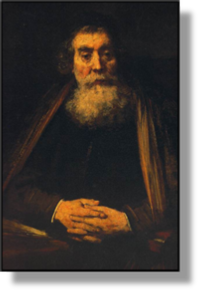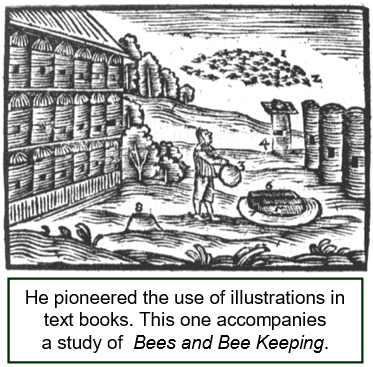


xxxxxJan Comenius
was a Moravian pastor who had ideas about education which were
well in advance of his time. In his Didactica
Opera Omnia (Complete Didactic Works)
published in 1657,
he argued that teaching had to be attuned to the mind of the
child. It was stimulation, assisted by pictures, models and music,
which was the key to learning, not coercion. He advocated full-
JAN COMENIUS
(born KOMENSKY)
1592 -
Acknowledgements
Comenius: portrait
by the Dutch painter Rembrandt van Rijn (1606-
 xxxxxJan Comenius was a Moravian pastor, later appointed a
bishop, whose advanced methods of teaching and detailed plans for
full-
xxxxxJan Comenius was a Moravian pastor, later appointed a
bishop, whose advanced methods of teaching and detailed plans for
full-
xxxxxHe was born at Nivnic, Moravia, the only son of a prominent member of a Protestant group called the Bohemian Brethren. He was orphaned at the age of 12 and was sent to school at Prerov. A bright lad, he was befriended by the headmaster and went on to the University of Heidelberg to study for the ministry. It was here that he read the works of Francis Bacon and became interested in science and its potential as a force for good. With the outbreak of the Thirty Years War in 1618, however, his life became, as he put it, "one long journey". To avoid persecution and the ravages of war he was obliged to keep on the move. Over the next fifty years he worked in Germany, Poland, England, Sweden, Hungary and Holland.

xxxxxHis overriding interest lay in education, and his advanced theories on this subject were set out in his first major work, The Great Didactic, completed in 1632. Teaching, he argued, needed to be attuned to the mind of the child. It was the ability to stimulate the pupil's interest, not coercion, that was the key to learning. To create such interest and reinforce the learning process, use must be made of supporting material, such as pictures, models and music. And alongside these novel teaching methods went an emphasis upon the teaching of Latin, vital, he insisted, for any real understanding of European culture. It was to this end that he produced his Gate of Tongues Unlocked in 1631, a type of Latin phrase book, in effect, which was translated into 16 languages and widely used throughout Europe.
xxxxxHis
educational system was no less radical. He advocated full-
 xxxxxThis attempt to reform human society via education
proved impractical. Bent on acquiring even the basic rudiments of
learning, the pupils proved incapable of understanding let alone
attaining the high and vague ideals which they had been set to
achieve. Nevertheless, this attempt at a "College of Light" was not
without benefit. It was Comenius who, while staying in England in
1641 and 1642, initiated discussions which led to the founding of
the Royal Society.
Likewise, it was due to his influence on the German philosopher
Gottfried Leibniz that the Berlin Academy was established. These
societies, and others like them, were a far cry from his grand
concept of a universal knowledge bringing about a universal
understanding, but they did serve as important centres of scientific
and cultural advancement.
xxxxxThis attempt to reform human society via education
proved impractical. Bent on acquiring even the basic rudiments of
learning, the pupils proved incapable of understanding let alone
attaining the high and vague ideals which they had been set to
achieve. Nevertheless, this attempt at a "College of Light" was not
without benefit. It was Comenius who, while staying in England in
1641 and 1642, initiated discussions which led to the founding of
the Royal Society.
Likewise, it was due to his influence on the German philosopher
Gottfried Leibniz that the Berlin Academy was established. These
societies, and others like them, were a far cry from his grand
concept of a universal knowledge bringing about a universal
understanding, but they did serve as important centres of scientific
and cultural advancement.
xxxxxAs a
religious leader he did much to ensure the survival of his faith and
to make possible the revival of the
Moravian Church. As a social reformer he may be seen, perhaps, as
the first international citizen. He was proud of his country, but
saw himself as a European, dedicated to political unity and
religious reconciliation. As an educational reformer he aimed, as he
wrote, "to teach thoroughly all things to all men". His efforts in
that direction earned him the title "Teacher of Nations".
Distinguished men such as the French philosopher Jean-
xxxxxIncidentally, the 20th century Austrian painter and playwright Oscar Kokoschka was a great admirer of Comenius and shared his humanistic views. In 1934, when painting a portrait of the great Czech Tomas Masaryk, the first president of Czechoslovakia, he paid a fitting tribute to the 17th century reformer by including his portrait in the background of the painting, thus providing a link between two patriots of past and present. The following year Kokoschka produced a play based on the life of Comenius.
CW-


